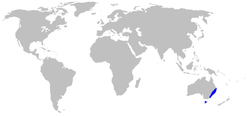| Christmas bells | |
|---|---|
 | |
| Illustration of Blandfordia grandiflora by Edward Minchen [1] | |
| Scientific classification | |
| Kingdom: | Plantae |
| Clade: | Tracheophytes |
| Clade: | Angiosperms |
| Clade: | Monocots |
| Order: | Asparagales |
| Family: | Blandfordiaceae R.Dahlgren & Clifford [2] |
| Genus: | Blandfordia Sm. [3] |
 | |
| Distribution | |
Blandfordia, commonly known as Christmas bells, [4] is a genus of four species of flowering plants native to eastern Australia. Christmas bells are tufted, perennial herbs with narrow, linear leaves and up to twenty large, drooping, cylindrical or bell-shaped flowers.